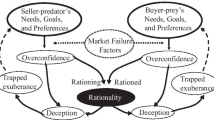Abstract
The behavior of the firm in a competitive market based on the idea of the human system, i.e., using a danger activator and a defence system, is modelled. The proposed model uses three variables: market share ratio, danger index and the ratio of relative investment between the firm and the total investments including the competition. The danger activator, the defence and the market reaction functions, which explain how the danger index becomes activated, how the firm reacts to a danger signal, and the market reaction to the firm’s actions, respectively, are carefully constructed. This leads to a parametric dynamic system that governs the behavior of the competitive market. The following five classical behaviors of a firm result: monopoly, below aimed market share, aimed market share, above aimed market share and out of market. Formulas for a sensitivity analysis are derived to determine how and how much the equilibrium points of the dynamic system change when the parameters change. All the concepts are illustrated by graphs that show the equilibrium points and the trajectories of the system.
Similar content being viewed by others
References
Burnet FM (1959) The clonal selection theory of adquired immunity. Vanderbilt University Press, Nashville
Casadesus-Masanell R, Ghemawat P (2006) Dynamic mixed duopoly: A model motivated by Linux vs. Windows. Strategy Unit Workin Paper No.04-012: IESE Working Paper No. D/519. Manage Sci (To appear)
Castillo E, Hadi AS, Conejo A, Fernández A (2004) A general Method for local sensitivity analysis with application to regression models and other problems. Technometrics 46(4):430–444
Castillo E, Conejo A, Castillo C, Mínguez R, Ortigosa D (2006a) A Perturbation approach to sensitivity analysis in nonlinear programming. J Opt. Theory App 128(1):49–74
Castillo E, Conejo A, Mínguez R, Castillo C (2006b) A closed formula for local sensitivity analysis in mathematical programming. Eng Optimi 38:93–112
Chen MJ, Hambrick DC (1995) Speed, stealth and selective attack: How small firms differ from large firms in competitive behavior. Acad Manage J 38:453–482
Chen MJ, Miller D (1994) Competitive attack, retaliation and performance: An expectancy-valence framework. Strateg Manage J 15:85–102
D’Aveni RA (1994) Hypercompetition. Free Press, New York
Ferrier WJ (2001) Navigating the competitive landscape: the drivers and consequences of competitive aggressiveness. Acad Manage J 44:858–877
Kirzner I (1973) Competition and Entrepreneurship. The University of Chicago Press, Chicago
Leonard-Barton D (1992) Core capabilities and core rigidities: A paradox in managing new product development. Strateg Manage J Summer Special Issue 13:111–125
MacCrimmon KR (1993) Do firm strategies exist?. Strateg Manage J 14:113–130
MacMillan IC (1980) How business strategists can use guerrilla warfare tactics. J Bus Strategy 1:63–65
Matzinger P (2002) The danger model: a renewed sense of self. Science 296:301–305
Mintzberg H, Waters JA (1985) Of strategies, deliberate and emergent". Strate Manage J 6:257–272
Mintzberg H (1987) Crafting strategy. Harvard bus rev 65:66–75
Porter ME (1990) The competitive advantage of nations. The Free Press, New York
Silverman B (2001) Sun microsystems, Inc.: Solaris strategy. HBS case 9-701–058
Teece DJ, Pisano G, Shuen A (1997) Dynamic capabilities and strategic management. Strate Manage J 18:509–533
Author information
Authors and Affiliations
Corresponding author
Rights and permissions
About this article
Cite this article
Castillo, E., Sarabia, M. & Álvarez, E. The danger model: application to a competitive market. CMS 4, 301–312 (2007). https://doi.org/10.1007/s10287-006-0025-9
Published:
Issue Date:
DOI: https://doi.org/10.1007/s10287-006-0025-9




